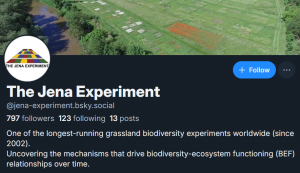New publication from Albracht et al. in Biology and Fertility of Soils: Common soil history is more important than plant history for arbuscular mycorrhizal community assembly in an experimental grassland diversity gradient
The relationship between biodiversity and ecosystem functioning strengthens with ecosystem age. However, the interplay between the plant diversity – ecosystem functioning relationship and Glomeromycotinian arbuscular mycorrhizal fungi (AMF) community assembly has not yet been scrutinized in this context, despite AMF’s role in plant survival and niche exploration. We study the development of AMF communities by disentangling soil- and plant-driven effects from calendar year effects. Within a long-term grassland biodiversity experiment, the pre-existing plant communities of varying plant diversity were re-established as split plots with combinations of common plant and soil histories: split plots with neither common plant nor soil history, with only soil but no plant history, and with both common plant and soil history. We found that bulk soil AMF communities were primarily shaped by common soil history, and additional common plant history had little effect. Further, the steepness of AMF diversity and plant diversity relationship did not strengthen over time, but AMF community evenness increased with common history. Specialisation of AMF towards plant species was low throughout, giving no indication of AMF communities specialising or diversifying over time. The potential of bulk soil AMF as mediators of variation in plant and microbial biomass over time and hence as drivers of biodiversity and ecosystem relationships was low. Our results suggest that soil processes may be key for the build-up of plant community-specific mycorrhizal communities with likely feedback effects on ecosystem productivity, but the plant-available mycorrhizal pool in bulk soil itself does not explain the strengthening of biodiversity and ecosystem relationships over time.

Reference:
Albracht, C., M. D. Solbach, J. Hennecke, L. Bassi, G. R. van der Ploeg, et al. 2024. Common soil history is more important than plant history for arbuscular mycorrhizal community assembly in an experimental grassland diversity gradient. Biology and Fertility of Soils. https://doi.org/10.1007/s00374-024-01821-0.



